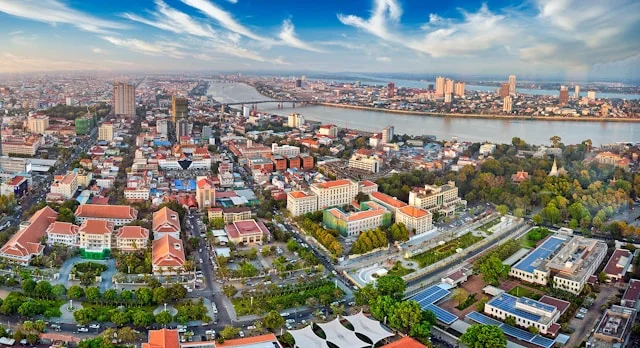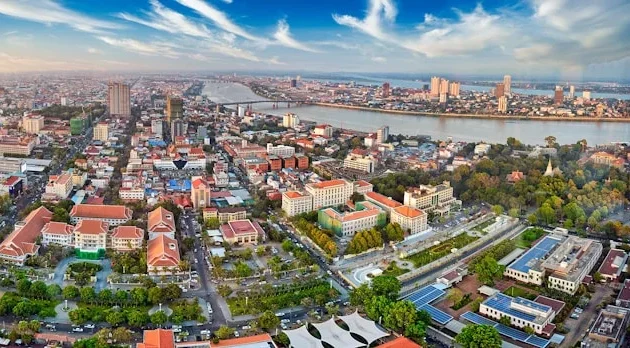
Phnom Penh, the bustling capital of Cambodia, is a city where history meets modernity. The streets of Phnom Penh are alive with energy, reflecting a blend of cultural heritage and contemporary development. As we stroll through the city, we are greeted by a vibrant tapestry of sights, sounds, and smells, each contributing to the unique character of Phnom Penh.
The Royal Palace and Silver Pagoda
One of the most iconic landmarks in Phnom Penh is the Royal Palace. This majestic complex, still the residence of the King, showcases the grandeur of Cambodian architecture. The adjacent Silver Pagoda is equally impressive, named for its floor made of 5,000 silver tiles. Inside, we find a dazzling array of Buddha statues, including the Emerald Buddha and a life-sized gold Maitreya Buddha adorned with diamonds.
The National Museum
A visit to the National Museum offers us a deeper understanding of Cambodia’s rich history and culture. Housing the world’s largest collection of Khmer art, the museum’s exhibits span from prehistoric times to the post-Angkorian period. The stunning collection includes sculptures, ceramics, and ethnographic objects that provide insight into the lives and beliefs of the Cambodian people.
The Killing Fields and Tuol Sleng Genocide Museum
While Phnom Penh is a city of vibrant life, it also bears the scars of a tragic past. The Killing Fields of Choeung Ek and the Tuol Sleng Genocide Museum are sobering reminders of the atrocities committed during the Khmer Rouge regime. As we walk through these sites, we are confronted with the harsh realities of history, yet also reminded of the resilience and strength of the Cambodian people.
The Journey to Siem Reap: Gateway to Angkor
Leaving Phnom Penh, we embark on a journey to Siem Reap, the gateway to the ancient temples of Angkor. The drive or flight to Siem Reap offers a scenic transition from urban landscapes to the lush, green countryside of Cambodia.
The Bustling Old Market (Psar Chaa)
Upon arrival in Siem Reap, we find ourselves drawn to the lively Old Market. Here, the vibrant stalls offer everything from fresh produce and spices to handmade crafts and souvenirs. The market is a sensory overload, with the sounds of vendors bargaining, the aroma of street food, and the colorful display of goods.
Pub Street: The Heart of Nightlife
As the sun sets, Pub Street comes alive with an array of restaurants, bars, and nightclubs. This bustling area is the epicenter of Siem Reap’s nightlife, offering a wide range of dining and entertainment options. Whether we are looking for traditional Khmer cuisine or international fare, Pub Street has something to satisfy every palate.
Exploring the Majestic Temples of Angkor
The highlight of any visit to Siem Reap is undoubtedly the exploration of the Angkor Archaeological Park. This UNESCO World Heritage site is home to some of the most impressive and well-preserved temples in the world.
Angkor Wat: The Crown Jewel
No trip to Siem Reap is complete without witnessing the grandeur of Angkor Wat. This temple complex, built in the early 12th century, is a marvel of engineering and artistry. As we approach the main entrance, the sight of the five towering spires against the backdrop of a sunrise or sunset leaves us in awe. The intricate carvings and bas-reliefs that adorn the walls tell stories of Hindu mythology and historical events, offering a glimpse into the past.
Bayon Temple: Faces of Serenity
In the heart of Angkor Thom, the ancient capital, lies the enigmatic Bayon Temple. Known for its 216 smiling stone faces, Bayon is a masterpiece of Buddhist architecture. Each face, believed to represent the Bodhisattva Avalokiteshvara, exudes a sense of serenity and compassion. As we wander through the labyrinthine corridors and climb the steep steps, we are transported to a different era.
Ta Prohm: Nature’s Embrace
Perhaps the most atmospheric of all the temples is Ta Prohm, famously featured in the film “Tomb Raider.” Unlike other temples, Ta Prohm has been left in much the same condition as it was found, with massive tree roots enveloping the ruins. This deliberate decision creates a hauntingly beautiful scene, where nature and human craftsmanship exist in perfect harmony.
Beyond the Temples: Siem Reap’s Hidden Gems
While the temples are the main draw, Siem Reap has much more to offer.
Tonle Sap Lake
A short drive from the city brings us to Tonle Sap Lake, Southeast Asia’s largest freshwater lake. The floating villages here provide a unique glimpse into the lives of the communities that depend on the lake for their livelihood. A boat tour allows us to observe stilt houses, floating markets, and the daily activities of the local people.
Phare, The Cambodian Circus

For an unforgettable cultural experience, we attend a performance by Phare, The Cambodian Circus. This nonprofit organization combines theater, music, dance, and circus arts to tell powerful stories that reflect Cambodian society and history. The performances are not only entertaining but also support the education and training of young artists from disadvantaged backgrounds.
Culinary Delights: A Taste of Cambodia
No journey is complete without indulging in the local cuisine. Cambodian food is a delightful blend of flavors and textures, influenced by its rich history and neighboring countries.
Amok Trey
One of the must-try dishes is Amok Trey, a traditional Cambodian fish curry. This dish is made with freshwater fish, coconut milk, and a blend of spices, all steamed in banana leaves. The result is a fragrant and creamy curry that melts in our mouths.
Lok Lak
Another popular dish is Lok Lak, stir-fried beef served with a tangy lime and black pepper dipping sauce. Often accompanied by rice and a fresh salad, Lok Lak is a flavorful and satisfying meal.
Street Food Adventures
Exploring the street food scene in both Phnom Penh and Siem Reap is a culinary adventure. From skewers of grilled meat to crispy spring rolls and refreshing fruit shakes, the street vendors offer a wide array of delicious and affordable options.